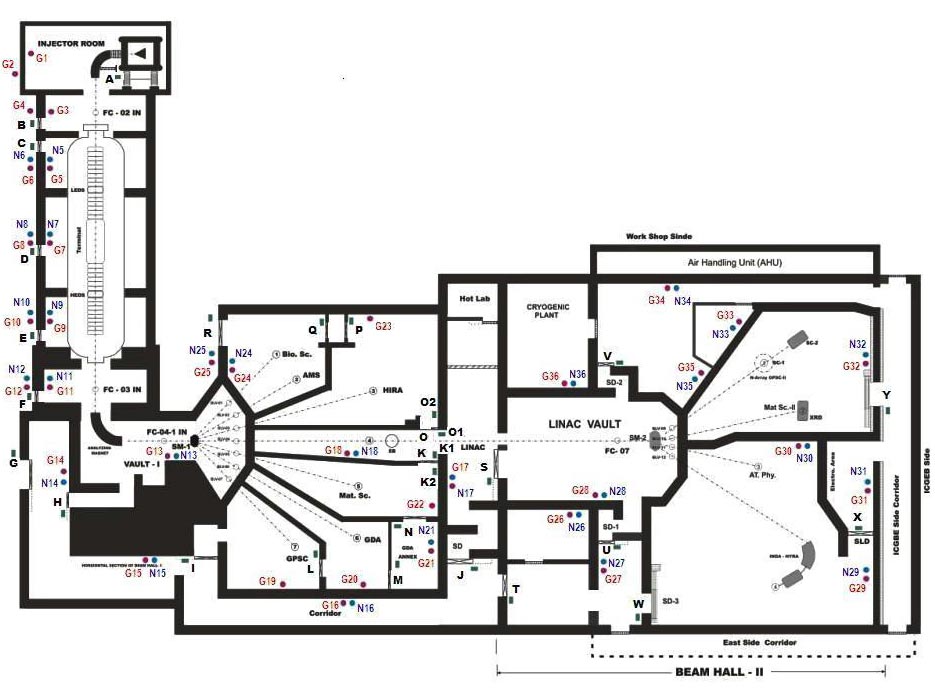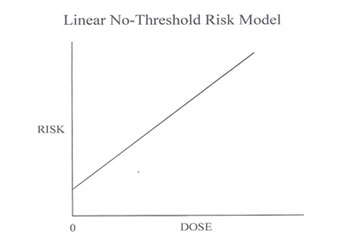Contact person
Mr. Debashish Sen
Health Physicist (Scientist G)/RSO Inter University Accelerator Centredsen@iuac.res.in
Video Lecture
Health Physics Activities and Facilities
The Health Physics Group in the Centre was set up primarily for monitoring and ensuring radiation safety of the Accelerator facility as is mandatory by the Atomic Energy Regulatory Board. The activities of the group have grown in the direction of radiation research beyond the routine regulatory duties. Over a decade, this group has produced excellent support for radiation safety. There are around 20 universities and around 30 research scholars, working with the health Physics group on various interdisciplinary research activities. A few NGOs and some Government Agencies have also used these facilities. The universities associated with this group are from all over the country. We are putting our best efforts to make these activities par excellence in coordination with the Atomic Energy Regulatory Board (AERB) and the various universities involved with the health physics group.
- Development of new Thermoluminescence Materials & its Dosimetry Applications.
- Radiation sources for Thickness Measurement
- Centrifuge machine
- Muffle furnace (1200 degree C)
- Spark counter
- TLD Reader
- Electronic Balance
- Distillation Set up
- Gamma irradiation Chamber
Radiation Environment at IUAC
The Primary Beam
The intense ion beam accelerated to high energies by the accelerator is itself a very strong source of radiation though this is not of much consequence as the ion beam gets invariably stopped inside the vacuum system.
Secondary Radiation
When the ion beam hits various parts of the vacuum system, target, etc. Secondary Radiation (mainly in the form of neutrons and gamma/X-rays) may be produced due to the nuclear reaction.
Induced Radioactivity
The Radioactive Nuclei may be produced when materials get irradiated either by the ion beam (primary beam) or the secondary radiation. The radiation emitted by this Induced Radioactivity may consist of electrons, positrons, particles, X-rays, gamma rays or combination of these rays.
Ionizing Radiation Resulting from Accelerator Operation
| Source | |
|---|---|
| Primary Ion beam (p, alpha, Li, B, Ni etc.) | Entire beam path, Accelerator and Beam line inside vacuum systems. |
| Neutron, Gamma rays & other secondary radiation | Beam Stops, Slits, Targets, etc. |
| Induced Radioactivity from Primary Beam | Beam Stops, probes Slits, Targets and Deflectors etc. |
| Induced Radioactivity from Secondary Radiation (Neutrons) | Vacuum chamber wall and Ion Source components. |
| X-rays | From High Voltage used in Ion Source |
The Accelerator laboratories are not accessible to a casual visitor. This is to avoid any exposure of the radiation to a person not being monitored for radiation.
When Beam is 'OFF'
There are no restricted areas for the lab staff when beam is 'OFF' excepting some of the areas which may have been found to have some significant residual activity during the regular area monitoring done by the Health Physics Group of the centre.
When Beam is 'ON'
There are radiation areas through which beam is passing and these areas are not accessible to any person. These areas are well shielded and properly interlocked to avoid any exposure to the lab workers.
With the radiation protection inbuilt in the system at iuac, the member of the staff and users will receive little or no exposure. However, regular personnel monitoring is necessary for every worker having access to the radiation areas.

The complete NLK System, Doors, Display Board along with the Radiation Monitors
Remember
Nobody should enter Tower, Beam Hall, Vault Area, and other radiation areas without TLD badge or pocket dosimeter. Users must consult the control room before going into the beam hall.
Radiation Protection
Basic postulates
- No practice shall be adopted unless its introduction produces a net positive benefit.
- All exposures shall be kept as low as reasonable achievable (ALARA), economic and social factors being taken into account.
- The dose equivalent to individual shall not exceed the limits recommended for appropriate circumstances by the commission.

It is the responsibility of each radiation worker to keep the dose to themselves and the people around them: ALARA (As low as reasonably achievable).
General consensus among experts is that some radiation risks are related to radiation dose by a linear, no-threshold model. This model is accepted by the NRC since it appears to be the most conservative.
- LINEAR - An increase in dose results in a proportional increase in risk
- NO-THRESHOLD - Any dose, no matter how small, produces some risk
The risk does not start at 0 because there is some risk of cancer, even with no occupational exposure. The slope of the line just means that a person that receives 5 rems in a year incurs 10 times as much risk as a person that receives 0.5 rems in a year. Exposure to radiation is not a guarantee of harm. However, because of the linear, no-threshold model, more exposure means more risk, and there is no dose of radiation so small that it will not have some effect.
Time, Distance & Shielding
Doses can be minimized by taking advantage of the following simple methods
- Reduce the amount of time spent near the radioactive material/source
- Increase the distance from the source
- Use appropriate shielding whenever possible
Exposure limit
- Occupational Exposure for all radiation workers 20mSv/yr or 2R/yr or 2000mR/(40X50)hrs or 1 mR/hr (10µSv/hr)
except
- Women of reproductive capacity dose limit to abdomen 1.3R (13mSv) per 3 months
- Pregnant women abdomen dose should not exceed 0.1 rem (1 mSv) from time of diagnosis of pregnancy till its termination.
- Members of general public: 0.1 mR/hr (1µSv/hr) (always much less than the occupational exposure)
Radiation Monitoring
helps to keep a check on the radiation doses received by the radiation workers and other persons in the vicinity.
Personnel Monitoring
helps in determining the accumulated radiation dose received by persons working with radiation sources (worn by the person)
TLD: Thermoluminescent Dosimeter
Release of visible light by heating a pre-irradiated TL material is called thermoluminescence. The thermoluminescence detector (TLD) utilizes the ability of some materials to trap the electrons from ionising radiation. After irradiation, this material is heated, allowing the release of the trapped electrons and, in the process, the release of a photon of light. The release of light photons is proportional to the radiation dose the detector has received. This thermoluminescence material is usually impregnated into a small card of Teflon. The card is housed in a holder.
Neutron Film Badge
Kodak Nuclear Track Emulsion type A (NTA) films are used. Fast neutron on undergoing elastic collision with content of the emulsion or the cellulose acetate base material produce recoil protons which are recorded as photographic tracks in the emulsion. The track density is a linear function of the dose
Badge Processing
Film and TLD badges must be kept in good condition. Both badges are usually processed every three months from BARC, Mumbai. The results are made available to the worker and are required by legislation to be kept by the IUAC for a period of at least 50 years after the last entry. The Health Physicist maintains a cumulative record of neutron film badge and TLD badge/pocket dosimeter doses for all registered users. Personal monitors are not transferable and should never be exchanged between individuals. These badges may give inaccurate assessment if subjected to pressure (finger nails, bending, ballpoint pens); wetting or laundering; exposure to extreme heat; some chemical vapour which can damage the card; storage near radioactive materials or X-ray equipment.
Digital Pocket Dosimeter
This is a compact battery operated, direct reading electronic pocket dosimeter, which incorporates a semiconductor detector. The instrument shows a dose or dose rate on a large 4-digit LCD. An accumulated dose can be stored and returned to zero by reset operation.
Area Monitoring
helps in determining the radiation levels (dose rate) at different places (installed in an area at a particular location or hand held monitors)
Basic Radiation Safety Guidelines for Dosimeter/Badge Users
- Monitoring Badges: When the Pelletron is operating, nobody is allowed to enter the Beam Hall and associated areas without appropriate badges/dosimeters. Issue and monitoring of radiation badges is done by HEALTH PHYSICIST/RSO. The badges or dosimeters are also provided for new comers and visitors to beam hall and other radiation areas. It must be returned to the Health Physics Laboratory before the user leaves the Institute.
- Always wear your assigned TLD badge/pocket dosimeter. TLD badge must be worn routinely. These badges are sent to BARC quarterly for processing.
- You can take your personal badge when you visit other facilities.
- Pocket dosimeter must be used for short-time visitors and radiation record will be maintained.
- Do not eat, drink, or smoke in the laboratory, except in specified areas. Eating includes gum, candy, and beverages.
- Gloves must be worn during operation in which contamination of hands is possible.
- Refrigerators must not be used jointly for food and laboratory materials.
- Store and transport radioactive materials in such a manner to prevent breakage or spillage.
- Users must contact the HEALTH PHYSICIST/RSO at IUAC on his arrival to collect his badge (pocket dosimeter), radioactive sources for detector calibration, etc. and obtain his clearance before leaving.
- All radiation workers, staff, and users from other universities/institutions are required to wear their assigned TLD badge/pocket dosimeters during their experiment.
- Door Interlock: All the doors of the beam hall should always be interlocked for all types of beams.
- No interlock bypassing will be permitted during the Experiment/Beam On, except in case of emergency only after the permission of RSO.
- Users must contact the operators/ LEC on duty for access to their experimental areas.
- Portable survey monitors will be available in the data room. Health Physicists may be contacted if the user feels that survey is necessary.
- Any radiation-concerned matter which is abnormal, must be reported immediately to the Chairman- safety Committee or Health Physicist/RSO. It is obligatory to report safety violations of any kind in writing to the Chairman of RSO as soon as possible.
Radioactive Sources & its Safe Handling in the Lab
Safe Handling
- Sources should be handled with forceps/gloves as far as possible, particularly for sources of more than 15 micro Curie strength. Sources should be kept as far as possible.
- All the radioactive materials should only be stored in specially designated areas maintained by the center.
- Sources should be handled carefully to avoid breaking seals
- Radioactive sources issued to any users/NCAR personnel should be returned to HEALTH PHYSICIST/RSO and not to any other user unless allowed by HEALTH PHYSICIST/RSO.
- Sources can be issued and returned only in the presence of HEALTH PHYSICIST/RSO.
- The expected date of return of the source is to be mentioned by the user at the time of its issue.
- The user should either return the source or ask for an extension within this date. On failure, after 24 hrs (Excluding holiday) of the expiry of this date, the source will be considered misplaced without further inquiry, and appropriate action initiated.
- Mishandling, misplacing, or breaking of the seal of any radioactive sources is a very serious violation.
- Violation of any of the above norms is likely to lead to permanent disqualification of the concerned users further from further use of radioactive sources in the future.



